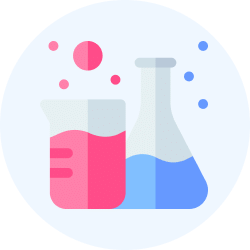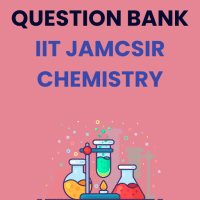Chemistry Exam > Chemistry Questions > Synthesis of each molecule of glucose in phot...
Start Learning for Free
Synthesis of each molecule of glucose in photosynthesis involves:
- a)18 molecules of ATP
- b)10 molecules of ATP
- c)8 molecules of ATP
- d)6 molecules of ATP
Correct answer is option 'A'. Can you explain this answer?
Most Upvoted Answer
Synthesis of each molecule of glucose in photosynthesis involves:a)18 ...
Overview:
The synthesis of each molecule of glucose in photosynthesis involves the utilization of ATP (adenosine triphosphate) as an energy source. ATP is a high-energy molecule that provides the necessary energy for various cellular processes, including glucose synthesis. In the process of photosynthesis, plants convert sunlight, water, and carbon dioxide into glucose and oxygen. The synthesis of glucose occurs through a series of complex reactions known as the Calvin cycle.
Explanation:
The Calvin cycle is the set of reactions that occur in the stroma of chloroplasts during photosynthesis. It involves a series of enzyme-catalyzed reactions that utilize ATP and NADPH (nicotinamide adenine dinucleotide phosphate) generated during the light-dependent reactions. The primary purpose of the Calvin cycle is the fixation of carbon dioxide and the synthesis of carbohydrates, particularly glucose.
Steps involved in glucose synthesis:
1. Carbon fixation:
- In the first step of the Calvin cycle, carbon dioxide molecules are incorporated into an organic molecule called ribulose-1,5-bisphosphate (RuBP).
- This reaction is catalyzed by the enzyme ribulose bisphosphate carboxylase/oxygenase (Rubisco).
- This process results in the formation of two molecules of 3-phosphoglycerate (3-PGA).
2. Reduction:
- The second step involves the conversion of 3-PGA into glyceraldehyde-3-phosphate (G3P).
- This conversion requires ATP and NADPH as energy and reducing power sources, respectively.
- Each molecule of 3-PGA is phosphorylated by ATP and reduced by NADPH to form G3P.
3. Regeneration:
- In the final step, G3P molecules are used to regenerate RuBP, which is necessary for the continuation of the Calvin cycle.
- Several ATP molecules are utilized in this step to convert G3P into RuBP.
ATP utilization in glucose synthesis:
- During the Calvin cycle, a total of 18 molecules of ATP are utilized in the synthesis of each molecule of glucose.
- ATP is involved in various steps of the cycle, including the phosphorylation of 3-PGA to form G3P and the regeneration of RuBP.
- The energy provided by ATP is essential for driving the endergonic reactions of glucose synthesis.
Therefore, the correct answer is option 'A' - 18 molecules of ATP.
The synthesis of each molecule of glucose in photosynthesis involves the utilization of ATP (adenosine triphosphate) as an energy source. ATP is a high-energy molecule that provides the necessary energy for various cellular processes, including glucose synthesis. In the process of photosynthesis, plants convert sunlight, water, and carbon dioxide into glucose and oxygen. The synthesis of glucose occurs through a series of complex reactions known as the Calvin cycle.
Explanation:
The Calvin cycle is the set of reactions that occur in the stroma of chloroplasts during photosynthesis. It involves a series of enzyme-catalyzed reactions that utilize ATP and NADPH (nicotinamide adenine dinucleotide phosphate) generated during the light-dependent reactions. The primary purpose of the Calvin cycle is the fixation of carbon dioxide and the synthesis of carbohydrates, particularly glucose.
Steps involved in glucose synthesis:
1. Carbon fixation:
- In the first step of the Calvin cycle, carbon dioxide molecules are incorporated into an organic molecule called ribulose-1,5-bisphosphate (RuBP).
- This reaction is catalyzed by the enzyme ribulose bisphosphate carboxylase/oxygenase (Rubisco).
- This process results in the formation of two molecules of 3-phosphoglycerate (3-PGA).
2. Reduction:
- The second step involves the conversion of 3-PGA into glyceraldehyde-3-phosphate (G3P).
- This conversion requires ATP and NADPH as energy and reducing power sources, respectively.
- Each molecule of 3-PGA is phosphorylated by ATP and reduced by NADPH to form G3P.
3. Regeneration:
- In the final step, G3P molecules are used to regenerate RuBP, which is necessary for the continuation of the Calvin cycle.
- Several ATP molecules are utilized in this step to convert G3P into RuBP.
ATP utilization in glucose synthesis:
- During the Calvin cycle, a total of 18 molecules of ATP are utilized in the synthesis of each molecule of glucose.
- ATP is involved in various steps of the cycle, including the phosphorylation of 3-PGA to form G3P and the regeneration of RuBP.
- The energy provided by ATP is essential for driving the endergonic reactions of glucose synthesis.
Therefore, the correct answer is option 'A' - 18 molecules of ATP.
Free Test
FREE
| Start Free Test |
Community Answer
Synthesis of each molecule of glucose in photosynthesis involves:a)18 ...
Option (A) is the right answer.

|
Explore Courses for Chemistry exam
|

|
Question Description
Synthesis of each molecule of glucose in photosynthesis involves:a)18 molecules of ATPb)10 molecules of ATPc)8 molecules of ATPd)6 molecules of ATPCorrect answer is option 'A'. Can you explain this answer? for Chemistry 2025 is part of Chemistry preparation. The Question and answers have been prepared according to the Chemistry exam syllabus. Information about Synthesis of each molecule of glucose in photosynthesis involves:a)18 molecules of ATPb)10 molecules of ATPc)8 molecules of ATPd)6 molecules of ATPCorrect answer is option 'A'. Can you explain this answer? covers all topics & solutions for Chemistry 2025 Exam. Find important definitions, questions, meanings, examples, exercises and tests below for Synthesis of each molecule of glucose in photosynthesis involves:a)18 molecules of ATPb)10 molecules of ATPc)8 molecules of ATPd)6 molecules of ATPCorrect answer is option 'A'. Can you explain this answer?.
Synthesis of each molecule of glucose in photosynthesis involves:a)18 molecules of ATPb)10 molecules of ATPc)8 molecules of ATPd)6 molecules of ATPCorrect answer is option 'A'. Can you explain this answer? for Chemistry 2025 is part of Chemistry preparation. The Question and answers have been prepared according to the Chemistry exam syllabus. Information about Synthesis of each molecule of glucose in photosynthesis involves:a)18 molecules of ATPb)10 molecules of ATPc)8 molecules of ATPd)6 molecules of ATPCorrect answer is option 'A'. Can you explain this answer? covers all topics & solutions for Chemistry 2025 Exam. Find important definitions, questions, meanings, examples, exercises and tests below for Synthesis of each molecule of glucose in photosynthesis involves:a)18 molecules of ATPb)10 molecules of ATPc)8 molecules of ATPd)6 molecules of ATPCorrect answer is option 'A'. Can you explain this answer?.
Solutions for Synthesis of each molecule of glucose in photosynthesis involves:a)18 molecules of ATPb)10 molecules of ATPc)8 molecules of ATPd)6 molecules of ATPCorrect answer is option 'A'. Can you explain this answer? in English & in Hindi are available as part of our courses for Chemistry.
Download more important topics, notes, lectures and mock test series for Chemistry Exam by signing up for free.
Here you can find the meaning of Synthesis of each molecule of glucose in photosynthesis involves:a)18 molecules of ATPb)10 molecules of ATPc)8 molecules of ATPd)6 molecules of ATPCorrect answer is option 'A'. Can you explain this answer? defined & explained in the simplest way possible. Besides giving the explanation of
Synthesis of each molecule of glucose in photosynthesis involves:a)18 molecules of ATPb)10 molecules of ATPc)8 molecules of ATPd)6 molecules of ATPCorrect answer is option 'A'. Can you explain this answer?, a detailed solution for Synthesis of each molecule of glucose in photosynthesis involves:a)18 molecules of ATPb)10 molecules of ATPc)8 molecules of ATPd)6 molecules of ATPCorrect answer is option 'A'. Can you explain this answer? has been provided alongside types of Synthesis of each molecule of glucose in photosynthesis involves:a)18 molecules of ATPb)10 molecules of ATPc)8 molecules of ATPd)6 molecules of ATPCorrect answer is option 'A'. Can you explain this answer? theory, EduRev gives you an
ample number of questions to practice Synthesis of each molecule of glucose in photosynthesis involves:a)18 molecules of ATPb)10 molecules of ATPc)8 molecules of ATPd)6 molecules of ATPCorrect answer is option 'A'. Can you explain this answer? tests, examples and also practice Chemistry tests.

|
Explore Courses for Chemistry exam
|

|
Signup for Free!
Signup to see your scores go up within 7 days! Learn & Practice with 1000+ FREE Notes, Videos & Tests.


















